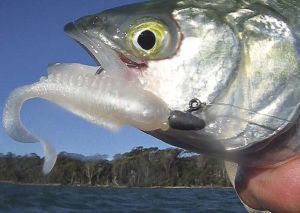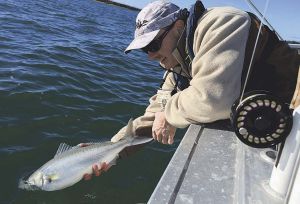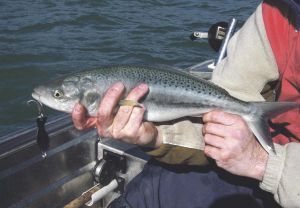 Presented from Issue 110, June 2014
Presented from Issue 110, June 2014
Winter is a time when we tend to slow down, the days are shorter and the weather is predictably cold, wet and windy. Some of us stop fishing all together and are happy to wait out the winter while others eagerly await the winter run of juvenile Australian Salmon. These fish often sneak into the quiet estuaries that are now free of summer anglers, skiers and jet skiers. They come into these estuaries to feed on the scattered bait schools, worms and prawns that live over the sea grass and shallow rocky shorelines.
Salmon schools will often move in and out of an estuary without any sign of them even being there.
One way to find them is to get out on the water with a sounder or simply troll a white or green 3 inch soft plastic around on an incoming tide. Of course you could always wait until you hear the whispers of their arrival through word of mouth or social media.
But sometimes that can be too late as Salmon have a tendency to be in the estuary one day and gone the next. Winter salmon are a great excuse to get the boat back on the water to see if they have returned. Besides, someone has to be the first to discover they are back.
 |
| No crowds, light winds and plenty of fish make estuaries fun |
Finding winter salmon
Because salmon are often feeding close to the bottom at this time of year I like to target relatively shallow water from 1 to 3 metres in depth where I know they will see and respond to a lure. A reliable time to find salmon is on an incoming tide from half tide to full tide. Trolling a lure over shallow rocky reefs or sea grass that have sand or muddy channels nearby is a good place to start.
Sometimes they can be found inside the estuary while on other days they will stay at the river mouth or along the coastal shoreline. Trolling a lure in along the rocky shallows and beaches is still a good idea when they are staying outside the estuary. Other anglers trolling or casting are obvious telltale signs of the presence of salmon in an area and a quick drive along the coast on an incoming tide will soon show where the fish are being caught. A friendly chat at the boat ramp never hurts either.
Tides and estuaries
An incoming tide is an obvious time to start fishing any estuary as it exposes the food rich tidal flats to an array of fish species. Typically, when the salmon move into an estuary the most productive stages of the tide will be when it has the most movement. From half tide to full is a very good time to be on the water. Then action will often slow or stop for a period at the top of the tide. If you can wait that period out, then the outgoing tide can also produce another chance to catch fish as they leave the estuary. When the tide is on its way out I like to fish the edge of the flats closer to the channels.
That way I can intercept those fish that have already dropped back in the channel from further up the estuary. This can be a good time to be on the water because many of the boats have given up and the salmon are on the look out for any baitfish dropping back into the channels. This is a great way to maximize your chances of boating a few more fish.
Tactics
Trolling lures over shallow water with a petrol or diesel engine is a very counter productive method. So as soon as I have caught one fish on a trolled lure I like to circle back around stop the motor and start casting lures or flies down the same location. Even starting up the boat after each drift can spook these fish so an even better way to increase my chances is to anchor the boat in a location where
I‘ve had multiple hook ups and allow the schools od salmon to come to me. If I arrive a bit late and see anchored boats catching salmon there is really no need for me to start trolling to find fish because it has already been done. All I have to do is give them a wide berth and anchor up below them and wait. Then the boat with bent rods and jumping fish above you becomes a very good indicator of when a school is pushing through.
One of the big tactical advantages of fishing from an anchored boat is the down and across swing you get when casting across the current. By doing this it allows the lure or fly to sink down to where the fish are and then swing up and across as it is retrieved the back of the boat. Salmon really respond well to this method, which can see 4 or 5 fish chasing the lure up towards the surface before one finally finds the hook. Incidentally this is the time for your fishing companions to cast a lure towards these already fired up fish before they move off and regroup with the passing school. Double hook ups are a regular occurrence when you’re fishing in stealth mode such as this.
Another really effective way of increase your catch rate from a stationary boat is to hold the passing school with a constant trail of fresh fish berley.
 |
| A silver spoon wobbler still works well |
 |
| Soft plastics are the ‘go to’ lure |
Lures
Australian salmon are more than willing to take a variety of lures be it hard body lures, metal slices, soft plastics or flies. So these fish are there to please all the different favored styles of lure angling. Interestingly someone preferred method of catching fish is not always the most productive. Many anglers are more than happy to catch less fish if they can continue to use their preferred method of fishing.
For these Juvenile Australian salmon small 2 to 3 inch lures in silver, white or green work well to replicate the small baitfish that are found in our estuaries. Lures that can be fished deep and close to the bottom are obviously going to have an advantage, which is why heavy metal lures, weighted soft plastics and flies work extremely well on these winter fish.
Salmon fever Salmon fever is something that surfaces in boating anglers who throw all angling edict out the window. Their uncontrollable need to catch a Salmon can have them motoring straight through a feeding school of salmon, putting the whole school down, while there were other boats trolling around the outer edge of the feeding school or boats drift downwind onto the school with their motors switched off. This same condition can be seen when boats troll too close to a stationary or drifting boat simply because these anglers are seen to be catching more fish. So the assumption is that this is the only place the school of salmon are. The reality is that many schools of salmon are continually moving in and out with the tide and it is the noise and the movement of boats trolling over shallow water that is scaring these fish away from their lures.
Please don’t get me wrong, sometimes trolling is the best method, particularly when it is done in deep water where the noise and movement of the boat has fare less of an effect on a school of salmon. When fish are threatened from a boat in deep water they can simply swim deeper to a level where they feel less vulnerable and in many instances they remain catchable down deep.
I’m afraid salmon fever is something that is just part of salmon fishing and in a way it’s quite understandable when you consider new anglers to the game are still learning the does and don’ts of catching these exciting fish for the first time.
Personally, when I’m struggling to catch fish I like to take a moment to watch and learn from those who are more successful than I and then try to introduce that technique into my own fishing. I believe you are never too young or old to learn something new in fishing, especially if you can keep an open mind and are willing to try something a little different to make your time on the water a little more successful and ultimately more enjoyable.
Craig Rist




